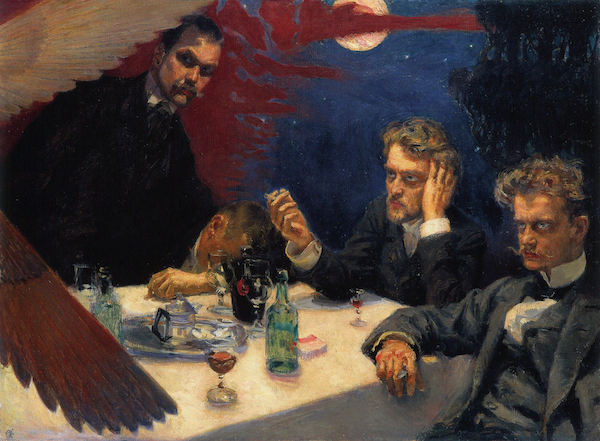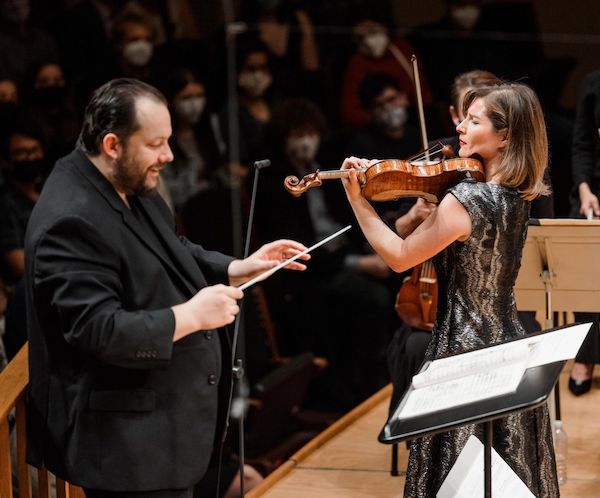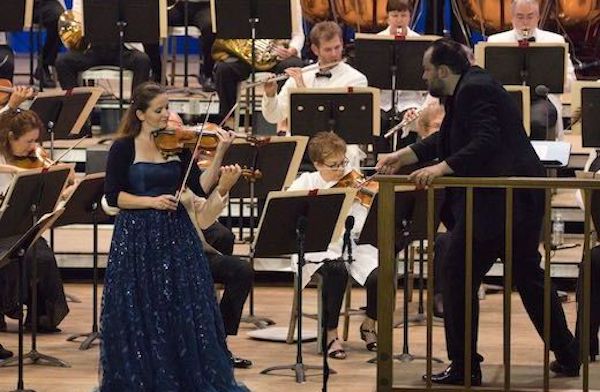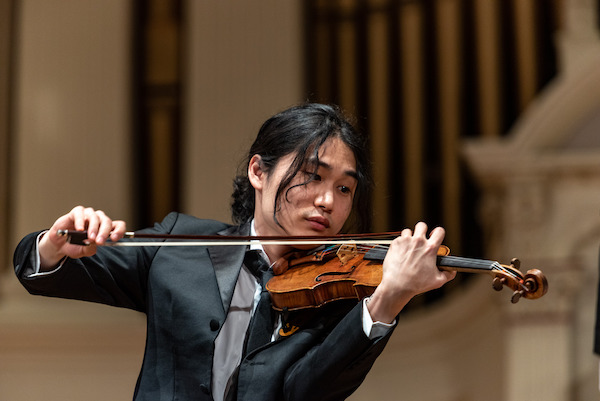Music Commentary: Jean Sibelius’s Violin Concerto — The Universal Concerto?
By Jonathan Blumhofer
Sibelius’s Violin Concerto is almost something of a phenomenon now: in just eight months, I’ve heard it played by three different fiddlers — Baiba Skride, Lisa Batiashvili, and Inmo Yang.

“Symposium” by Askeli Gallen-Kallela. Composers Jean Sibelius, Robert Kajanus, Oskar Merikanto, and Gallen-Kallela (r to l) in various states of inebriation, ca. 1894.
Call it the Universal Concerto. “You don’t have to be a musician to understand its sense of mystery,” the conductor-composer Leif Segerstam told Gramophone some years back. “Somehow the flow of its communication is slow enough to allow anybody to catch on to its meaning.”
He was talking about Jean Sibelius’s Violin Concerto in D minor. Now established, with Elgar’s violin and cello concertos, as one of the last great Romantic concerti, its success was by no means assured when Sibelius completed the first version of the piece in late 1903.
At the time, the composer, four years removed from the triumph of his nationalist hymn, Finlandia, was in financial doldrums: despite having received a generous pension from the Finnish government, he was deeply in debt and struggling with alcoholism. So, when the opportunity for a quick pay-day presented itself in February 1904, Sibelius offered the premiere of his new Violin Concerto – which had been intended for the German virtuoso, Willy Burmester – to the Helsinki-based violinist Viktor Nováček.
Whether Nováček was unprepared or simply unequal to the work’s demands (or possibly both) remains a point of debate; either way, the Concerto’s first performance was a debacle. Afterwards, Sibelius withdrew the score and revised it, unveiling the version we’re familiar with today in Berlin in 1905.
On that occasion, Burmester again wasn’t the soloist: unavailable for the concert date, the honor went, instead, to the Berlin Philharmonic Orchestra’s concertmaster, Karel Halíř (Richard Strauss conducted the Berlin Court Orchestra). Piqued at being passed over twice, Burmester refused to perform the piece and Sibelius ultimately dedicated the published edition to the prodigy Ferenc von Vecsey.
Given this tortured pedigree, it’s perhaps not surprising that the Concerto took some time to establish itself in the repertoire. While Maud Powell gave the American premiere at Carnegie Hall in November 1906 (she was also the soloist in the Boston Symphony Orchestra’s first performance of the score at Symphony Hall five months later), the piece only appeared in concert sparingly over the next twenty years: the BSO returned to it with Powell, again, in 1912 and Richard Burgin as soloist in 1924. Meanwhile the New York Philharmonic reprised it just twice, too, in 1911 (with Powell) and 1922 (with Alexander Schmuller).
It wasn’t until Jascha Heifetz’s acclaimed 1935 recording with the London Philharmonic Orchestra and Sir Thomas Beecham that the Sibelius Violin Concerto finally emerged from the wilderness. Indeed, by the time of the composer’s death in 1957, this once overlooked piece of his stood as the most widely-performed and popular of 20th-century violin concerti.
So it’s largely remained, despite a wildly fluctuating consensus on Sibelius’s place in the canon. To be sure, it’s hard to imagine another composer who’s been, on the one hand, so furiously reviled and, on the other, as unreservedly admired by so many people as Sibelius.
To Virgil Thomson, Sibelius was, like Tchaikovsky and Shostakovich, a “demagogic symphonist,” his music “vulgar, self-indulgent, and provincial beyond all description.” Or, as René Leibowitz put it in the title of his pamphlet, Sibelius: The Worst Composer in the World. In a similar vein, Theodor Adorno argued that Sibelius’s music “lacks any good qualities.”
Olin Downes, the longtime music critic of The New York Times, took the opposite view, hailing Sibelius as “the last of the heroes” and “a new prophet.” Meantime, the BSO’s Serge Koussevitzky – whose legacy of commissions included Stravinsky’s Symphony of Psalms and Bartók’s Concerto for Orchestra – waited for years (and in vain) for Sibelius to write him an Eighth Symphony.
For the next several generations of 20th-century Finnish composers, the great man’s shadow was understandably oppressive. Some, like Esa-Pekka Salonen, Magnus Lindberg, and Kaija Saariaho initially rejected his influence, only to later make reassessments (Salonen, in particular, has become one of Sibelius’s most persuasive interpreters).
Looking back, most of the complaints leveled against Sibelius’s oeuvre in the 20th century seem passé if not outright misguided. Many of them were, in fact, rooted in one of two phenomena: 1) an offense at the composer’s reticence to embrace his era’s trends towards atonality and hyper-intellectualism, and/or 2) a degree of professional jealousy. It’s telling, perhaps, that Sibelius drew the ire of the both the otherwise mutually-antagonistic cults of Stravinsky and Schoenberg. While today we can see their sniping for the mere partisan bickering it was, it caused Sibelius no end of grief and helped undercut his already shaky self-confidence: after 1927, the “silence of Järvenpää” descended and Sibelius put his pen away for good.

Violinist Lisa Batiashvili, BSO music director Andris Nelsons, and the Boston Symphony Orchestra performing the Sibelius Violin Concerto at Symphony Hall. Photo: Aram Boghosian.
Yet Sibelius’s music has continued to remain in the public eye even as much of Schoenberg’s – and some of Stravinsky’s – has receded. Nothing of the former’s, for instance, has held the popular imagination quite like the Sibelius Violin Concerto. Indeed, since it finally caught on nearly ninety years ago, the piece has rarely relaxed its grip, either on players or audiences.
That shouldn’t be surprising. Sibelius was one of a tiny number of major composers – Elgar was another – who was trained as a violinist. (Interestingly, Sibelius hated his childhood piano lessons, a fact seemingly borne out in the consistently ungainly voicings of his often quite beautiful keyboard output.) Though he took up the violin too late to realize his dream of becoming a virtuoso, Sibelius’s intimate knowledge of the instrument’s technical and expressive capabilities inform every page of the Concerto.
They’re evident from the soloist’s first entrance – a serenely dissonant G-natural that hovers over a bed of D-minor tremolos in the orchestra before resolving up a step – as much as in the furious sixteenth-note runs and sequences of double- and triple-stopped figures that follow. So, too, in the glorious Adagio’s fervent double-stop counterpoint and the finale’s seething brilliance, culminating in its wild leaps and flying scales.
Then there’s the Concerto’s overriding tone. The writing is often tempestuous, periodically verging on the operatic. Sometimes, like in the slow middle movement, it is breathtakingly fragile. At others, though, there’s a striking toughness of character. That’s especially true of the finale, with its snapping polonaise patterns and subtle rhythmic cross-currents. Throughout, there’s little sense of back-and-forth between soloist and orchestra: Sibelius, the thwarted virtuoso, always gives the solo violin the starring role.
Formally, the Concerto’s most striking feature is the first-movement cadenza. Here, Sibelius ingeniously repurposed what is traditionally a showy adjunct to the musical proceedings as the movement’s development, effectively turning it into the music’s beating heart.
Even so, not everyone was impressed. The violinist Joseph Joachim, for one, didn’t care for the Concerto at all: “dreadful and boring” was his verdict. And it’s true that the Sibelius isn’t the easiest repertoire staple on the ears, being neither so songful as Mendelssohn’s nor as playful as Tchaikovsky’s.
Knowing the composer’s psychological history and tendency to work himself subtly into his music, that, too, isn’t unexpected. In 1927, Sibelius wrote in his diary of “isolation and loneliness…driving me to despair” – and that was after he had seemingly overcome a host of demons. How many of them had subconsciously found their way into so important a piece written in the most tumultuous decade of his life more than twenty years prior? Probably quite a few, as violinist Tasmin Little seems to acknowledge: “It’s such a dark and searing piece,” she told Gramophone in an interview that appeared next to Segerstam’s in 2000, “if you want to taste the depths and heights of experience, this is the concerto to listen to.”

Violinist Baiba Skride, Andris Nelsons and the Boston Symphony Orchestra performing the Sibelius Violin Concerto at Tanglewood. Photo: Hilary Scott.
Perhaps that helps explain the Sibelius’s prevalence on local concert programs since live performance started up again last summer. It’s almost something of a phenomenon now: in just eight months, I’ve heard the Sibelius Violin Concerto played by three different fiddlers – Baiba Skride, Lisa Batiashvili, and Inmo Yang. And, thanks to a mix of interpretive prerogative and programmatic context, each of these performances revealed the essential flexibility and depth of the Concerto’s musical arguments.
Skride, who played it with the BSO at Tanglewood last July, drew out its rhapsodic qualities. By virtue of an occasional penchant for broad tempos – and thanks to hearing the Concerto played alongside Dvorak’s bucolic Symphony No. 6 – her performance further emphasized the sweeping sense of physical space that Sibelius’s writing often conjures.
Scope and character defined Batiashvili’s interpretation (also with the BSO) at Symphony Hall. A violinist whose playing combines beautiful tone, nimble fingerwork, and a mighty degree of personality, her October performance thrived on the Concerto’s expressive contrasts, running from ardent one moment to sneeringly diabolical the next. Here, too, one of the night’s other offerings enhanced the effect: Richard Strauss’s sumptuous “Symphonic Fantasy” on Die Frau ohne Schatten made for a perfect late-Romantic foil.
Equally striking was Yang’s account of the piece last week at Worcester’s Mechanics Hall. Playing with the regional orchestra Symphony Pro Musica, Yang sailed through the Concerto’s difficulties. His facility was astonishing: it’s not invoking hyperbole to compare the seeming effortlessness with which he navigated the music’s technical demands, the purity of his tone, and the evenness of his projection with the pristine execution of Heifetz. Yet there was an intensity and humanity to Yang’s shaping of the solo line that one doesn’t always experience in recordings by the older violinist.
While Yang’s reading didn’t mine the music’s extremes of character to the degree Batiashvili’s did, it sang with a beguiling naturalness that winningly echoed the afternoon’s other fare: a sparkling account of Lily Boulanger’s D’un matin de Printemps and a well-directed, invigorating Tchaikovsky Pathétique Symphony.
Despite the variety of their interpretive approaches, all three violinists demonstrated a bracing grasp of the music’s underlying tenacity, a quality that, to my ears, is one of the score’s most striking and appealing traits.

Violinist Inmo Yang performing the Sibelius Violin Concerto with the Symphony Pro Musica at Worcester’s Mechanics Hall. Photo: Andy Weigl.
To be sure, both outer movements evince a sense of struggle that’s peculiar for a concerto finished in 1905. Notably, there’s no feeling of release after the slow movement: Sibelius’s finale drives inexorably – even angrily at times – in ways that Beethoven’s, Mendelssohn’s, Brahms’s, and Tchaikovsky’s don’t. “He doesn’t give away the last movement in a playful way,” Little observed. “Perhaps that’s why it’s not the first concerto people reach for when they want an emotional lift.”
Even so, the Concerto’s rewards – particularly those derived from the music’s unflinchingly direct and perseverant spirit – are real. Often enough, in fact, the piece feels preternaturally du jour. That’s certainly how it came across in these recent performances, its thoroughgoing battles of ideas seeming to closely mirror the thrust and parry of so many bigger debates ongoing in our wider society.
Not that Sibelius necessarily saw the piece in such explicitly programmatic terms. When he and Gustav Mahler met in Helsinki in 1907, the two great composers exchanged views on the symphony. In response to Sibelius’s assertions that “profound logic” and “severity of form” should hold sway, Mahler famously retorted, “No! The symphony must be like the world. It must embrace everything.”
The case can be made that Sibelius increasingly took this advice to heart over the next twenty years. I’d posit, too, that the Violin Concerto demonstrates a discreet fusion of something not unlike Mahler’s unguarded emotionalism with Sibelius’s more naturally austere voice. Accordingly, it’s a singular effort, at once highly abstract yet, simultaneously, deeply personal. Indeed, this convergence of intractable opposites provides the music its underlying tension and, perhaps more than anything else, is the key for the listener intent to “catch on to its meaning.”
Jonathan Blumhofer is a composer and violist who has been active in the greater Boston area since 2004. His music has received numerous awards and been performed by various ensembles, including the American Composers Orchestra, Kiev Philharmonic, Camerata Chicago, Xanthos Ensemble, and Juventas New Music Group. Since receiving his doctorate from Boston University in 2010, Jon has taught at Clark University, Worcester Polytechnic Institute, and online for the University of Phoenix, in addition to writing music criticism for the Worcester Telegram & Gazette.
Tagged: Baiba Skride, Inmo Yang, Jean-sibelius, Jonathan Blumofer, Lisa Batiashvili

